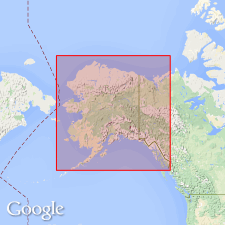
- Usage in publication:
-
- Tugidak Formation*
- Modifications:
-
- Named
- Dominant lithology:
-
- Sandstone
- Siltstone
- Conglomerate
- AAPG geologic province:
-
- Alaska Southwestern region
- Kodiak province
Summary:
Named for Tugidak Island, AK. Type section designated as exposures along west coast of Tugidak Island, 25 km southwest of Kodiak Island. Is only bedrock unit underlying Tugidak Island; also occurs at north end of Chirikof Island. Consists of interbedded sandstone and siltstone. A 1-m-thick cobble-conglomerate bed occurs about 350 m above base. Thickness at type is approximately 1500 m. On Chirikof Island unit is in fault contact with older rocks; conformably underlies unnamed Pleistocene rocks. Marine fossils identified by F.S. MacNeil (written commun., 1963) are Pliocene age. Age of unit is Pliocene.
Source: GNU records (USGS DDS-6; Menlo GNULEX).

- Usage in publication:
-
- Tugidak Formation*
- Modifications:
-
- Age modified
- AAPG geologic province:
-
- Alaska Southwestern region
- Kodiak province
Summary:
Age changed from Pliocene to: late Pliocene and early Pleistocene based on age of fossils.
Source: GNU records (USGS DDS-6; Menlo GNULEX).
For more information, please contact Nancy Stamm, Geologic Names Committee Secretary.
Asterisk (*) indicates published by U.S. Geological Survey authors.
"No current usage" (†) implies that a name has been abandoned or has fallen into disuse. Former usage and, if known, replacement name given in parentheses ( ).
Slash (/) indicates name conflicts with nomenclatural guidelines (CSN, 1933; ACSN, 1961, 1970; NACSN, 1983, 2005, 2021). May be explained within brackets ([ ]).

